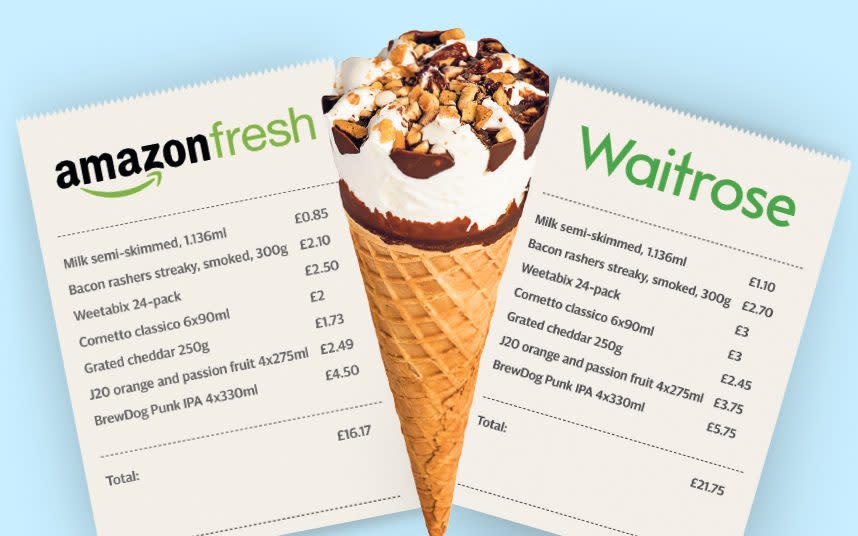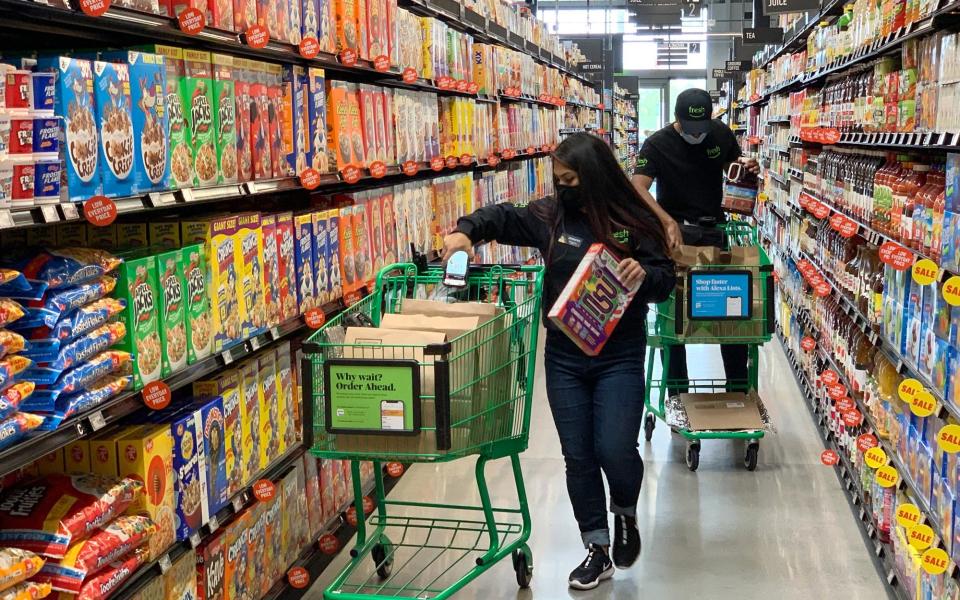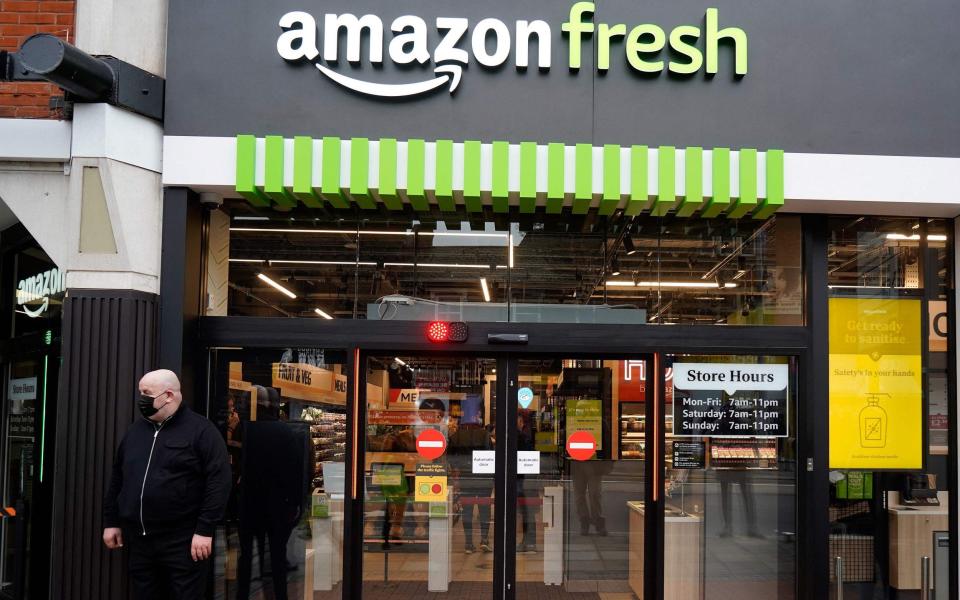Amazon battles to bag reputation for cheapest groceries

When Amazon bought upmarket grocer Whole Foods in the US, supermarkets around the world trembled with fear.
One major chain brought in a band of consultants whose sole mission for 12 weeks straight was to work out “what’s the threat of Amazon”.
Since that $13.7bn (£11.6bn) purchase in 2017, the behemoth has sought to woo shoppers with its till-less grocery stores, free home delivery via its Prime membership and a refined product offering.
Still, Amazon’s food arm remains small both across the pond and in the UK compared with incumbents.
Now, as inflation creeps in and energy bills increase, the main battleground for grocers to gain an edge is to be competitive on price in an effort to hold onto existing shoppers and attract new ones.
Amazon appears to be doing just that. It is a tactic that could help the Seattle-based company bolster its fledgling position in the sector.
It had a cheaper basket than the Big Four and Waitrose, according to the Grocer’s weekly mystery shopping service earlier this month. A total of 33 products – spanning both branded and private label – were tracked using website data. For the total list, Waitrose was considerably more expensive at £88.49, coming in more than 20pc higher than Amazon’s £73.60.
Bacon rashers, for instance, were £2.10 versus £2.50 at Asda, Sainsbury’s and Tesco, £2.67 at Morrison’s and £2.70 at Waitrose. Brewdog’s Punk IPA was at least £1 cheaper than competitors’ prices.
Amazon also undercut all rivals on items such as grated cheddar, J2O and Cornetto ice creams, and had the lowest overall price increases versus other grocers compared to last year.
“Grocery pricing is critical to success,” said William Woods at Bernstein in a recent note. “After rent or mortgage payments and transport, groceries are the largest category of spending for many people and the search to manage or reduce costs is key to many households’ budgeting efforts.”
The e-commerce giant is understood to be plotting a campaign to raise awareness about its affordable prices.
Miya Knights, who co-wrote a book about Amazon, says: “When they are put up against each other, Amazon is in the best position to beat all of these guys at an absolute key time when it comes to the cost of living crisis.
“They are just as competitive on groceries as they are on general merchandise – it’s essential, they’ve already invested a huge amount of money in the UK.”
Clive Black, a retail analyst at Shore Capital, adds that Amazon “has driven itself to be pretty competitive on a small basket.”
Amazon’s grocery offering is a mishmash of Morrisons, Co-op and Booths products as well as own-label and other branded goods.

Industry observers believe that despite its general dominance, Amazon lacks the might of the likes of Tesco in demanding lower prices from major food brands. Its competitiveness rests instead on investing in prices to keep them low.
“Is Amazon Fresh actually making any money? Probably not. So it’s just treated like an investment or an innovation project, they can just hold them [products] at really low [profit] margins,” says one source.
The Grocer’s data also showed Amazon had increased prices less than the leading supermarkets.
Its basket cost 3.7pc more than last year, while Tesco’s prices were up 4.9pc. Asda’s rose 15.2pc compared to last July, while Morrisons and Sainsbury’s prices gained 10.6pc and 9.4pc respectively. Waitrose had the largest increase, up 7pc on last year.
While it hasn’t passed on as much inflation, the numbers suggest it was quite expensive before.
Black says: “All retailers are inflating at the moment. All Amazon is doing is matching an inflating basket. It is not exactly rebasing industry pricing activity.”

Having opened its first grocery stores in the capital last March, there are now 19 Amazon Fresh stores in London, with speculation the company could target 260 sites by 2025.
Helping it achieve its bricks and mortar ambitions is Tony Hoggett, a Tesco veteran who joined Jeff Bezos’ company last year after more than three decades with the supermarket. He is in charge of physical stores worldwide.
But even if the e-commerce firm was to have a couple of hundred shops, it would still be a laggard when judging by numbers. German discounters Aldi and Lidl, which continue to open branches apace, are targeting an estate of more than 1,000 shops each in the next few years, for instance.
Earlier this year, competition chiefs declared that Amazon officially became a supermarket as it made £1bn or more from grocery sales. Nevertheless, it is dwarfed by Tesco’s £61bn in annual sales and Sainsbury’s £29bn, and is barely flickering when it comes to market share.
That means the task of selling groceries to more shoppers in the UK’s hyper-competitive grocery arena will be herculean.
“I think it’s fair to say they haven’t set British grocery alight. The anecdotal evidence is that they are very quiet. It’s early days for the business, but a handful of stores is quite meaningless. For them to become meaningful, that estate needs to balloon quite materially,” says Black.
“The one thing Amazon has is enormous resources to see through its plans. It is also an organisation that has absolutely shown that it has patience and it works on its own timescale and not everyone else’s.”
That doesn’t mean Amazon’s food section isn’t of importance. Knight adds: “Strategically they need groceries, food is a large proportion of spend, and so they’re missing out on about 40pc. They can’t afford to let that spend go to other competitors.”
Russell Jones, director of Amazon Fresh, says the company has always been focused on delivering low prices every day.
“Amazon Fresh is committed to making it as easy as possible for customers to find good value products in the face of rising living costs for customers around the country,” he says.
But while it is seemingly able to keep food prices low, executives are fighting hard to tackle inflation in other parts of the business. Earlier this year, management said it is now impractical not to pass some of these costs on.
In February, Amazon hiked its Prime membership in the US for the first time in four years, from $119 to $139. It subsequently introduced a 5pc fee for some sellers to cover fuel and inflation that would apply to any merchants who use Amazon’s fulfilment system. Sellers that do their own shipping and delivery were not affected.
In April, Amazon posted its first quarterly loss since 2015 as sales slowed, costs rose and its investment in electric vehicle company Rivian wiped out profits. The company incurred $2bn in additional costs after a hiring spree during the pandemic lockdowns to keep up with demand.
In the UK, it is being investigated by the competition watchdog over fears shoppers could get a raw deal because it is prioritising the promotion of its own products. Amazon previously said it was working with the regulator, adding that more than half of the products it sells are from small businesses.
Despite Amazon having held its own as it battles other grocers, climbing inflation will force it to fight harder than ever for shoppers’ every penny.

 Yahoo Finance
Yahoo Finance 